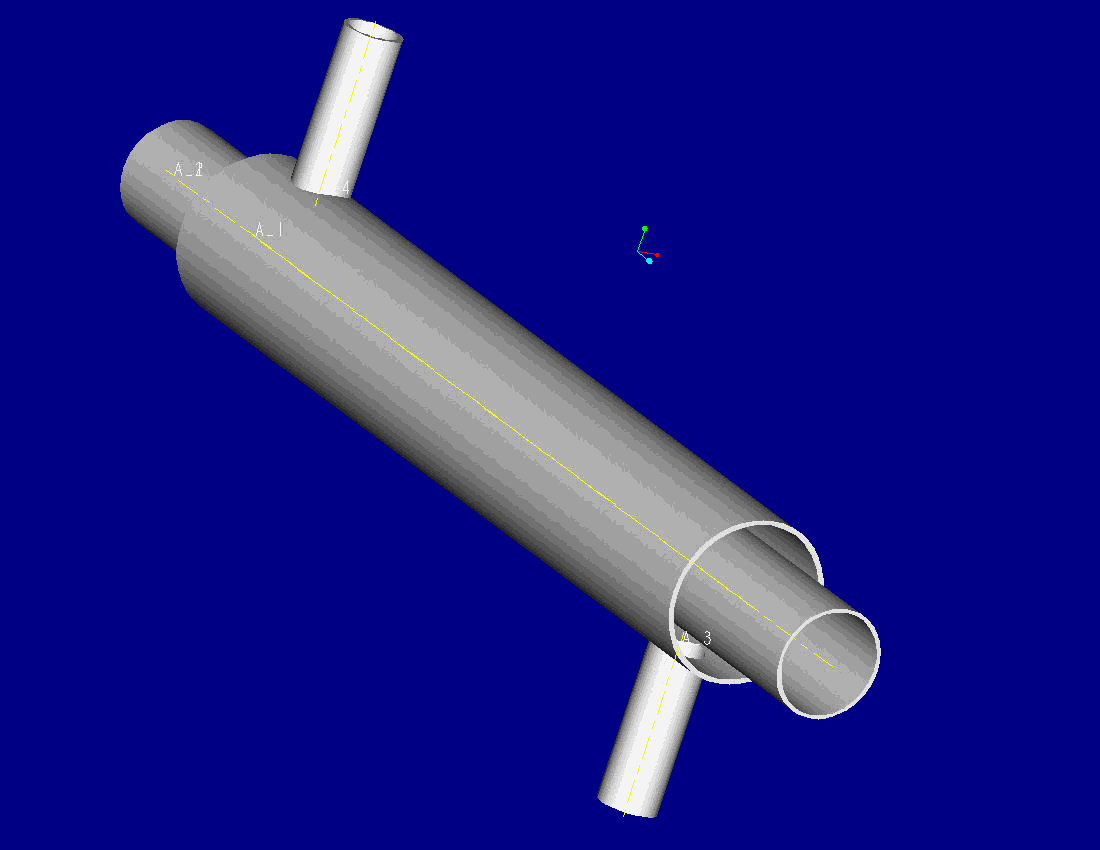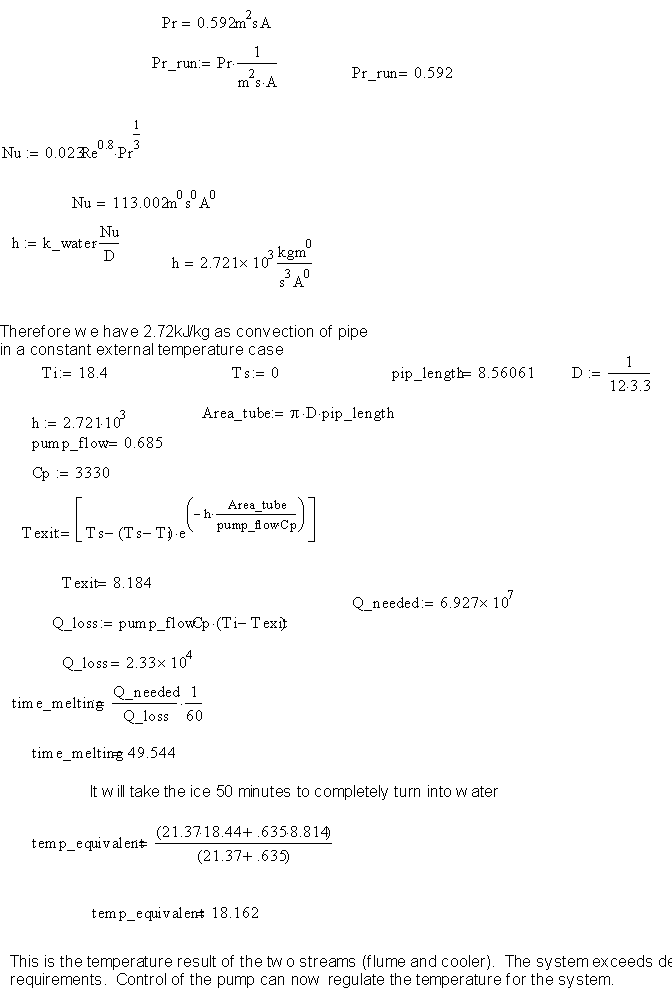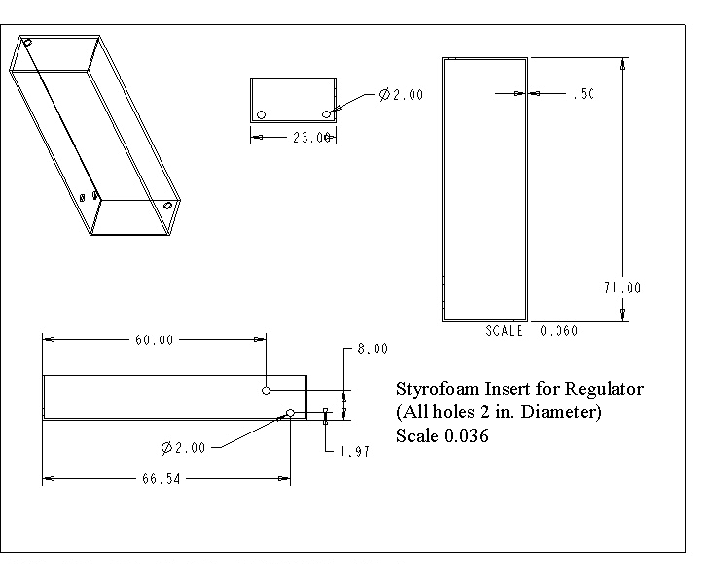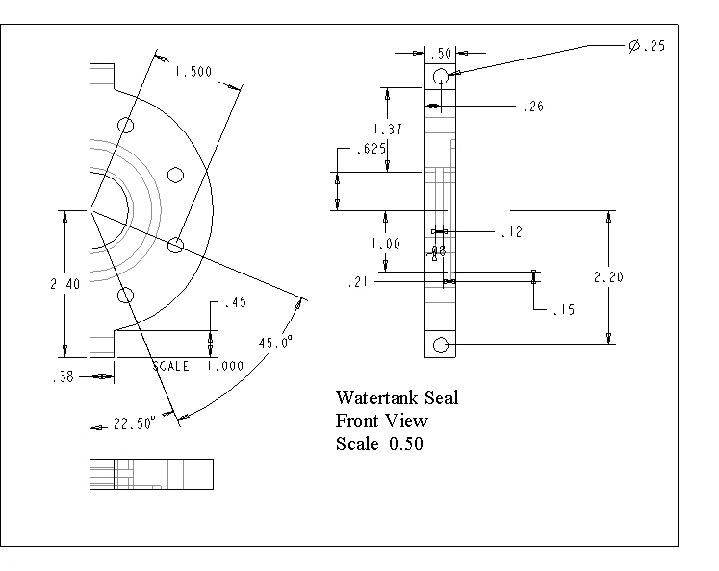 Back
to Spring Reports
Back
to Spring Reports
Saltwater Flume Project:
Final Report
EML 4551C: Senior Design Project
Dr. Luongo Instruct.
Dr. Thistle Client
04/05/2001
Coastline Research Inc.
Design Team 10
Takenya Williams
Ivan Lee
Arnett Flowers
1.0. Introduction
2.0. Customer Needs Assessment
3.0. Preliminary Design Specifications
3.1. Design
Team Specifications
3.2. First
Design Concept
3.3. Second
Design Concept
3.4. Third
Design Concept
4.0. Final Design Concept
5.0. Conclusion
Appendix A
Appendix
B
Appendix
C
Appendix
D
Temperature changes can be a major cause of error in an experiment. They can cause data readings to be slightly off and inconsistent, which is the case with the salt water flume at the Florida State University (FSU) Marine Laboratory. A temperature regulator is needed to solve the problem completely, and eliminate any error caused by temperature changes.

Figure 1.1: Water Flume
The design for the temperature regulator of the salt water flume begins with the basic flume itself. The salt water flume is an apparatus that is used by marine biologist and oceanographers to conduct experiments using sea water. Figure 1 shows a drawing of the water flume.
The sea water is pumped into the marine laboratory and collected in a holding tank. The water is then pumped into head tank using any combination of one to four pumps. Each pump has about 1 hp and the motor is about 3450 rpm. The water is moved through PVC piping. The head tank is basically another type of holding tank. It allows the excess water to collect in it before it flows into the flume. It acts as a break to slow down the flow of the water. The water then passes to the filters and into the flume. The filters aid in the process of keeping the water flow at an even and uniform flow throughout the width if the flume. The water flows through the flume and collects again in the holding tank. The process repeats itself for the duration of the experiment, reusing the water in the holding tank.
The problem that the marine biologist and oceanographers are having with the flume is the temperature changes. In the initial design of the flume, a temperature change in the water was not a conceived problem. Recently, it was discovered that the water in the flume was being slightly heated up by the pumps by about 10o –20o. To keep the temperature the constant throughout the duration of the experiment, a temperature regular must be added to the flume.
A temperature regulating device is an apparatus that aids in keeping the temperature constant. Most simple types of these devices are composed of a thermocouple or some other type of temperature sensing device, a thermostat indicator, and a cooling or heating device. The cooling device may consist of a fan or some type of system using a coolant like antifreeze. Heating devices main components consist of heating coils. Some temperature regulating devices also come with thermostat controllers, which allow the user to set a certain temperature for the regulator to maintain.
2.0. Customer Needs Assessment
Several meetings with Dr. Thistle were conducted on the Florida State University campus as well as the Marine Research Facility at Alligator Point. During the interviews the client stated the following items which the Temperature Regulator would have to perform:
Client Needs and Wants Statement:
3.0. Preliminary Design
Specifications
At the visits to the Florida State University Marine Lab, measurements of the current system were taken. Questions were asked and experiments were conducted to gather initial data on how the system performed. This led to the newer specifications stated below:
3.1. Design Team Specifications
The house of quality (Table 3.1.1 in Appendix A) was constructed to distinguish the importance of each specification. This took the nineteen specifications and put them against various categories (such as operator, price, safety, and etc.). The relationships between the specifications and the categories were ranked to see which would objectively be the first to be focused upon. A matrix on the top to compare the relationships between the categories was also constructed. The system was ranked based on 9’s, 3’s, 1’s, and blanks. Nines showed the strongest relationships while 1’s were marginally related. A blank space represents trivial or no relationship between the categories. This helped to show on which specifications the team should focus.
An above head heat exchanger was the concept was first introduced. The
idea was to extract water from the reservoir into a box of cool fluid and
to cool down the water through conduction. Several problems developed for
this concept. First of all, the fluid temperature inside the box is hard
to control. Second, the marine biologists need the space above the flume
to observe their experiments. A large box installed above the flume will
obstruct their working space. Therefore, the above head heat exchanger
is not feasible for this project.

| Figure 3.1: Above head heat exchanger. |
A counter flow heat exchanger is the second concept. An external pipe
is wrapped around a section of the pipe, which comes out of the reservoir
and into the head tank. Cooling fluid travels in the opposite direction
of the return flow. In this way, heat is extracted from the pipe flow before
it returns to the head tank. The problem with this design is that the diameter
of the heat exchanger is too large for it to be mounted to the wall. Also,
PVC pipes were used for the return link. Since PVC is not a good conductor,
it is difficult to obtain heat transfer through these pipes. A longer and
larger counter flow heat exchanger is then needed which obviously cannot
be done due to the restricted space.

| Figure 3.2: Counter flow heat exchanger. |
The third design concept is to isolate the pump from the motor thus
eliminate the heat transfer to take place. This is a very radical concept,
which should work in theory, but in reality it will not be feasible. One
of the many problems is that isolating the pump and motor will mean that
disassembling the existing pump will be necessary. By disassembling, it
will void the manufacturer’s warranty. Second, an extended shaft will be
needed. By extending the shaft, there will be very difficult to align the
pump and motor and it may not be reliable. Also extra research in material
for the shaft is necessary and customizing the shaft will be very expensive.
Therefore, the sponsor did not approve this concept.

| Figure 3.3: Pump isolating system. |
Dr. Thistle and the machinist decided on the idea of buying a chiller that is already being manufactured in the market and installing it into the reservoir. Experiments were conducted to decide the size and power of the chiller that is capable for the salt-water flume. The experiment results are expressed in Appendix C. From this experiment, a decision was made to purchase a chiller from Frigid Unit Incorporation, Model D1-33. According to the company, this unit is recommended for a control volume between 100 to 200 gallons and can also set the desired temperature to be between 35-70F. The salt-water flume’s condition is within the specified range of this chiller unit, therefore, this is a perfect match for our problem. Figure 4 is a picture of the Frigid Units Model D1-33 chiller.

| Figure 4.1 Frigid Units Model D1-33. |
This chiller weights approximately 85 pounds and can fit easily into
the limited space where the salt-water flume is installed. This unit is
specifically made for behavior studies, research and university labs/water
pollution research, any research or development where controlled water
conditioning is necessary. It has 1/3 HP motor and the compressor is rated
at 4,000 BTU/hr. This unit should be excellent in the aspects of performance
and ease of installation onto the salt-water flume.
The process of engineering is very complex. It incorporates a great deal of knowledge communication skills, creativity, resourcefulness and circumstance. The Coastline Research team has followed a design from problem statement to concept visualization to product implementation. This process has taken great time, patience, and understanding. This separates the layman from the engineer. Whereas the layman would use a short decision process or advertisement to solve a problem, the engineer would take painstaking detail to find out if a decision is good; not just for today, but several years into the future.
This report details the engineering process of the Coastline group. Specifications, Concept Drawings, client communication, and mathematical equations have been grouped together to show how and why the group provided it recommendations to the their client, Dr. David Thistle. In addition, it also includes the alternative generated concept and its engineering drawings. This information is provided for future reference on additional projects which may be generated to service and or upgrade the Saltwater Flume itself, or modifications and performance analysis of the Temperature regulator.
A program of actual client experience as part of education provides an excellent opportunity for students to hone their skills and put all of the engineering education in the context of real-world application.

Figure 3.1.2: WBS


Experiment
Measurements of temperature change in Flume
Objectives
Our goals of this experiment are to observe the temperature change in
the flume, to study the conversation of mass and energy in a control volume.
Theoretical Background
The first physical principle to which we apply the relation between system and control volume formulations is conservation of mass. It is intuitive that mass can be neither created nor destroyed, if the flow rate of mass into a control volume exceeds the rate of flow out, mass will accumulate within the CV.
The conservation of mass states simply that the mass of a system is constant,
dm/dt system = 0 (1)
Where,
Msystem = ?M(system) dm = ?v(system) ? dv (2)
Then,
0 = d/dt ?CV ? dv + ?CS ? v .dA (3)
In Equation 3 the first term represents the rate of change of mass within the control volume, the second term represents the net rate of mass flux out through the control surface. Conservation of mass requires that the sum of the rate of change of mass within the control volume and the net rate of mass outflow through the control surface be zero.
Conservation of energy for a control volume, if the inflow and generation of energy exceed the outflow, there will be an increase in the amount of energy stored (accumulated) in the control volume, if the converse is true, there will be a decrease in energy storage. If the inflow and generation of energy equal the outflow, a steady-state condition must prevail in which there will be no change in the amount of energy stored in the control volume.
In applying energy conservation to the control volume, the first step is to identify the control surface and then identify the energy terms. These include the rate at which thermal and mechanical energy enter and leave though the control surface, Ein and Eout. Also, thermal energy may be created within the control volume due to conversion from other energy forms. We refer to this process as energy generation, and the rate at which it occurs is designated as Eg. The rate of change of energy stored within the control volume Est. A general form of the energy conservation may be expressed as
Ein + Eg - Eout = Est
In this experiment, our control volume is the water flume. We will monitor the change in temperature due to the thermal energy that comes from the four pumps and enter the water flume.
Experimental procedure
Method 1 – turn on one pump
We have the water flume as our control volume and we want to measure the temperature change due to the heat generated by one pump. We first run the water in flume and make sure that it reaches study state. In other words, water flows in equal water flows out of the flume, mass conservation. Then we turn one pump for half an hour and then start taking measurements for the temperature of the water. For accuracy measurements are taken every five minutes and for half an hour period.
Method 2 – turn on four pumps
We turn four pumps and start immediately taking temperature measurements of the water in the flume. Also, measurements are taken every five minutes for one-hour period.
Experiment Data Sheet
Table5.2: One pump
|
|
|
|
|
|
|
|
|
|
|
|
|
|
|
|
|
|
|
|
|
|
|
|
Table5.3: Four pump
|
|
|
|
|
|
|
|
|
|
|
|
|
|
|
|
|
|
|
|
|
|
|
|
|
|
|
|
|
|
|
|
|
|
|
|
|
|
|
|
|
|
Results and Conclusion

Figure 5.3: temperature change with one pump working

Figure 5.4 Temperature change with four pumps working
Looking at Figure 5.3, we hardly see any changing in temperature due
to the heat generated by one pump. So we exclude the effect of one pump.
Figure 5.4 shows the effect of the heat generated from four pumps on the
temperature gradient of the water. These measurements are very helpful
when it comes to choose the right chiller to keep the temperature in steady
state. Applying conservation of energy and conservation of mass can lead
us to the chiller that keeps the temperature stable.
Detailed Drawings and Calculations
This sections presents all major engineering drawings and the inventory list
Generator:__________________________________________________
Checker:
_______________________________________________________________
Approved: ____________________________________________________________

Figure 4.1: Three primary Views of assembled Temperature Regulator

Figure 4.2: Engineering Drawing of assembled outer box of unit

Figure 4.3: Engineering Drawing of Assembled foam insert

Figure 4.4: Engineering Drawing of the Exterior Seal Half (two are put
together to complete seal)
The following is a listing of the materials needed to build the Temperature
regulator. Most of the materials are readily available in Tallahassee.
Table 4.1: Inventory Table for the Temperature Regulator
|
|
|
|
|
|
|
|
Exchanger Hose | 8.8m | Rubber & Plastic | Lowe’s |
|
|
1-3/4" coupling (2 in O.D.) | 2 | PVC | Lowe’s |
|
|
1" coupling (1-1/4 O.D.) | 2 | PVC | Lowe’s |
|
|
1" 90 elbows | 8 | PVC | Lowe’s |
|
|
Liquid Gasket Sealant | 2 | Rubber | Lowe’s |
|
|
Foam insert | 0.024m^3 | Styrofoam sheeting | Lowe’s |
|
|
Outer walls | 0.026m^3 | Plexiglas | Lowe’s |
|
|
1" tubing | 12.12m | PVC | Lowe’s |
|
|
Ice | 150kg | Desalinated Water | Ice machine |
|
|
700 Gal/h submersible pump | 1 | Product information TBD | Pond Master |
|
|
Half water seals | 4 | Plexiglas | Machined supplier TBD |
|
|
1" shutoff valve | 1 | PVC | Lowe’s |
|
|
Aquarium Sealant | 1 | Silicon Caulking | Lowe’s or Wal-Mart |
|
|
¼"-20x2" Lag bolts | 4 | Zinc coated Steel | Lowe’s |
|
|
¼"-20 Washers | 8 | Zinc coated Steel | Lowe’s |
|
|
¼" Nuts | 4 | Zinc coated Steel | Lowe’s |
|
|
¼"-20x1" Machine screws | TBD | Stainless Steel | Lowe’s or Home Depot |
|
|
Lock-Tite | 1 | Polymers | Lowe’s or Home Depot |
|
|
Tubing clamps | 4 | Stainless Steel | Lowe’s |
|
|
Epoxy | 2 | epoxy | Lowe’s |
|
|
4" I.D. pipe section | Schedule 40 PVC | Lowe’s | |
|
|
4" Diameter Disk ½" thick | 1 | Plexiglas | Lowe’s |
|
|
Assembly labor | TBD | ||
| *All costs of materials per unit have not been determined | ||||